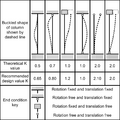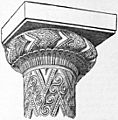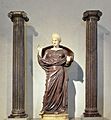Column facts for kids

Imagine a tall, strong pole that holds up a building! That's pretty much what a column is in architecture. It's a tall, upright part that carries the weight from the top of a building down to its base. Columns can be made from one big piece or several pieces stacked up. They often help support beams or arches, which then hold up walls or ceilings.
Contents
A Look Back: History of Columns
Columns have been around for a very, very long time! People in ancient Egypt started using stone columns way back in 2600 BC. That's over 4,600 years ago! They used them in their amazing temples and buildings.
Later, the ancient Greeks and Romans also used columns a lot. They even created different styles, which we still see today!
Different Styles of Columns
Over time, people developed many different styles, or "orders," for columns. Each style has its own special look, especially at the top part, called the capital.
Greek Column Styles
The ancient Greeks created three main styles:
Doric Columns
The Doric order is the oldest and simplest style.
- They are sturdy and plain.
- The top (capital) is just a simple, round shape.
- You can see them in famous buildings like the Parthenon in Greece.
Ionic Columns
The Ionic order is a bit more decorative.
- They are thinner than Doric columns.
- Their capitals have a scroll-like shape, like a ram's horns.
- They look elegant and graceful.
Corinthian Columns
The Corinthian order is the most fancy Greek style.
- They are tall and slender.
- Their capitals are decorated with carvings of acanthus leaves.
- This style became very popular with the Romans too.
Roman Column Styles
The Romans took the Greek styles and added their own.
Tuscan Columns
The Tuscan order is a simpler version of the Doric.
- It's very plain and strong.
- It doesn't have the fluted (grooved) sides that Doric columns often have.
Composite Columns
The Composite order mixes the Ionic and Corinthian styles.
- Its capital has both the scrolls of the Ionic and the acanthus leaves of the Corinthian.
- It's a very grand and detailed style.
Columns in Modern Buildings
Even today, columns are used in many buildings. Sometimes they are there to hold up the structure, just like they did thousands of years ago. Other times, they are used just for decoration, to make a building look grand and important. You can find them in government buildings, museums, and even some homes!
Images for kids
-
National Capitol Columns at the United States National Arboretum in Washington, D.C.
-
Column of the Gordon Monument in Waterloo.
-
Dragon pillar from the Yingzao Fashi, Song dynasty
-
Plan, front view and side view of a typical Persepolis column, of Persia (Iran)
-
Illustration of various types of capitals, drawn by the egyptologist Karl Richard Lepsius
-
Columns with Hathoric capitals
-
Papyriform columns of the Luxor Temple
-
Minoan columns at the West Bastion of the Palace of Knossos
-
Illustration of the end of a Mycenaean column, from the Tomb of Agamemnon
-
Illustration of the Doric order
-
Illustration of the Ionic order
-
Evolution of the Corinthian order
-
Praying Woman between two ionic columns, 2nd century, marble, in the Louvre
-
Byzantine columns from Basilica of Sant'Apollinare Nuovo (Ravenna, Italy)
-
The capital of a Byzantine column from Hagia Sophia (Istanbul, Turkey)
-
Slender Gothic columns at a portal of Marienkirche Gelnhausen (Gelnhausen, Germany)
-
Column use is common in Ottoman architecture, an example in Topkapı Palace (Istanbul, Turkey)
-
The Great Hypostyle Hall from Karnak (Egypt)
-
At right, two of the Solomonic columns brought to Rome by Constantine, in their present-day location on a pier in St. Peter's Basilica (Rome). In the foreground at left is part of Bernini's Baldachin, inspired by the original columns.
-
Tuscan columns can be seen at the University of Virginia
-
Church of San Prospero (Reggio Emilia, Italy)
-
Construction of Sigismund's Column in Warsaw, detail of the 1646 engraving.
-
These are composed of stacked segments and finished in the Corinthian style, at the Temple of Bel (Syria)
-
The pillars of Bankstown Reservoir (Sydney, Australia)
-
Engaged columns embedded in the side walls of the cella of the Maison Carrée in Nîmes (France)
See also
 In Spanish: Columna (arquitectura) para niños
In Spanish: Columna (arquitectura) para niños







































